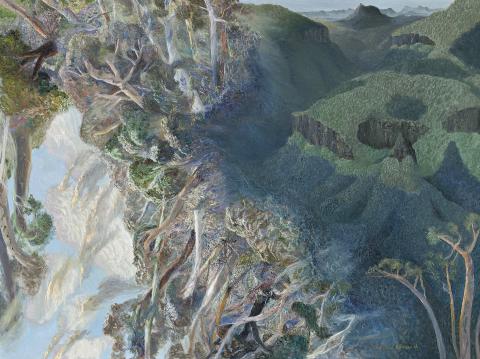SPRINGBROOK AND NUMINBAH TO MT WARNING, 1996
WILLIAM ROBINSON
oil on linen
92.0 x 121.5 cm
signed and dated lower right: William Robinson 96
inscribed with title verso: SPRINGBROOK AND NUMINBAH (sic) TO MT WARNING
Ray Hughes Gallery, Sydney
The Collection of Colin and Elizabeth Laverty, Sydney, acquired from the above in 1996
William Robinson, Ray Hughes Gallery, Sydney, 28 June – 24 July 1996, cat. 20 (illus. in exhibition catalogue)
William Robinson: The Revelation of Landscape, National Trust S.H Ervin Gallery, Sydney, 11 January – 2 March 2003; Mornington Peninsula Regional Gallery, Victoria, 28 March – 18 May 2003
William Robinson: The Revelation of Landscape, University of South Australia Art Museum, Adelaide, 27 February – 3 April 2004
Klepac, L., William Robinson – Paintings 1987 – 2000, The Beagle Press, Sydney, 2001, pp. 118 – 119 (illus.)
The view that Robinson depicts in Springbrook and Numinbah to Mt Warning, 1996, is a panoramic vision which spans millennia. The title of the picture directs the viewer from Springbrook in the north of the Gold Coast hinterland directly south over Numinbah to the distant remnants of the Tweed Volcano. This extinct volcano is a recurring theme in Robinson’s work from this time – it self-destructed 36 million years ago and is known today as Mount Warning. The presence of this ancient form far off in the distance brings perspective to the work and evokes the sense of timelessness which is a feature of Robinson’s work of this period – time and space are the overarching themes of the painting. Deborah Hart contributed to the third major monograph on the artist and in the passage below reflects on the breadth of the artist’s work.
‘In relation to a sense of place, Robinson has made a unique contribution to the Australian landscape tradition, moving beyond conventional notions of ‘landscape’ to encompass a fluctuating environment; of rainforest and ocean, ground and sky, day and night, elemental forces of wind, lighting, rain and fire. His multidimensional grasp of time and space also suggests metaphors for states of mind and being, life and death, continuity and transcendence..... The profound spiritual resonances in Robinson’s art remind us of the need to preserve an ancient natural world in the present; “to keep the faith”, as Simon Schama wrote in Landscape and Memory “with a future on this tough, lovely old planet”’.1
Springbrook and Numinbah to Mt Warning, 1996, is a classic example of Robinson’s landscape painting. He flaunts his skills as a colourist and again uses his device of multiple view points within the one picture plain. He also uses vastly different techniques when applying the paint in the major passages of the painting. The mediative application of the deep greens and granite greys in the right side of the composition are used by the artist specifically to depict the ancient features of the landscape and evoke his timeless quality. In the left passage of the painting, Robinson deploys upbeat staccato brushwork, which brings a present day contemporary feel to the picture. The forest of Antarctic Beech trees depicted, within the time frame and context of the painting, amount to new growth and the passing clouds bring an ephemeral element to the work, which further presses the notion of time passing.
1. Hart, D., ‘William Robinson’s artistic development: An intimate and expansive journey’, in Hart, D., William Robinson, A Transfigured Landscape, Queensland University of Technology and Piper Press, Brisbane, 2011, p. 38
HENRY MULHOLLAND
